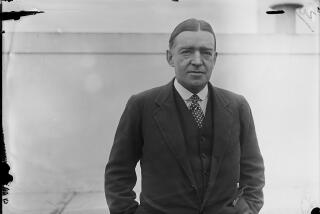‘Russia’s Columbus’ Gets Double Acclaim
HORSENS, Denmark — Danes and Russians are celebrating the 250th anniversary of a voyage by Danish explorer Vitus Bering--a man they believe ranks with Christopher Columbus in opening up the frontiers of the world.
In 1741, Bering discovered the straits separating Siberia and Alaska--which now bear his name--while leading a voyage of exploration for the czarist Russian navy.
His discovery of Alaska spurred a wave of Russian colonial expansion in North America.
“In the Soviet Union, Bering is still known as ‘Russia’s Columbus,’ ” said historian Ole Schioerring, head of the local museum in Horsens, the explorer’s birthplace.
Bering, who was born in 1681, was shipwrecked and died on the return leg of his pioneering voyage.
Interest in the explorer was stirred last August when Danish and Soviet archeologists found his long-lost remains on a wind-swept beach on Bering Island, off the Kamchatka Peninsula in eastern Siberia.
Schioerring said: “Bering not only discovered that the Russian and American land masses were separated by a 100-kilometer (60-mile) strait but was also the first to survey the Alaskan coastline.
“While Columbus discovered America from the Atlantic, Bering was the first to discover the continent from the east, opening up the first white settlement of Alaska--the original Russian America.”
Then in 1867 Czar Alexander II sold Alaska to the United States for $7.2 million.
A major film is planned about Bering’s life, and two of his Russian descendants are attending anniversary ceremonies in Horsens this month.
“Bering was suffering from gangrene,” said Schioerring. “He died Dec. 8, 1741, on the remote island which now bears his name after his ship sank on its return voyage from Alaska.”
Schioerring, who took part in the search, said the size of the skeleton matched what was known of Bering. “We also unearthed five other members of the expedition buried in nearby trenches. . . . Records refer to them but say that only Bering was buried in a wooden coffin,” he said.
There were no trees on the island. “His makeshift coffin was put together out of driftwood and wreckage from his ship, his corpse wrapped in canvas from its sails,” Schioerring said.
Bering’s bones are now in Moscow, where Soviet pathologists are working on a reconstruction of his face based on his skull and surviving remnants of skin tissue. They plan to rebury the explorer’s remains on Bering Island in August.
Bering enlisted in Czar Peter the Great’s Imperial Russian Navy at the age of 22, a young man in search of adventure.
“The Soviets see Bering’s voyages and discoveries as momentous events in their history, establishing Russia as a major Asian power and bringing it immeasurable economic benefits and influence,” Schioerring said.
He added that although Bering served a foreign monarch, the explorer is nevertheless considered one of Denmark’s greatest heroes.
Bering’s first expedition, one of the longest and most arduous in history, involved 400 men and lasted from 1725 to 1730. He charted the coastline of northern Siberia from Kamchatka to 67 degrees north but failed to establish whether Asia and America are joined.
It was during his second expedition that ships captained by Bering and his Russian second-in-command, Aleksei Chirikov, sighted Alaska in July, 1741.
But the punishing conditions took their toll, and Bering and 31 of the 78 crewmen of his ship died.
More to Read
Sign up for Essential California
The most important California stories and recommendations in your inbox every morning.
You may occasionally receive promotional content from the Los Angeles Times.









